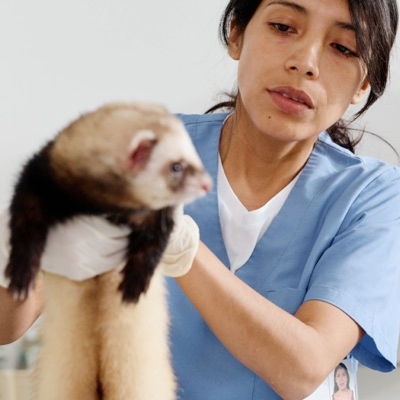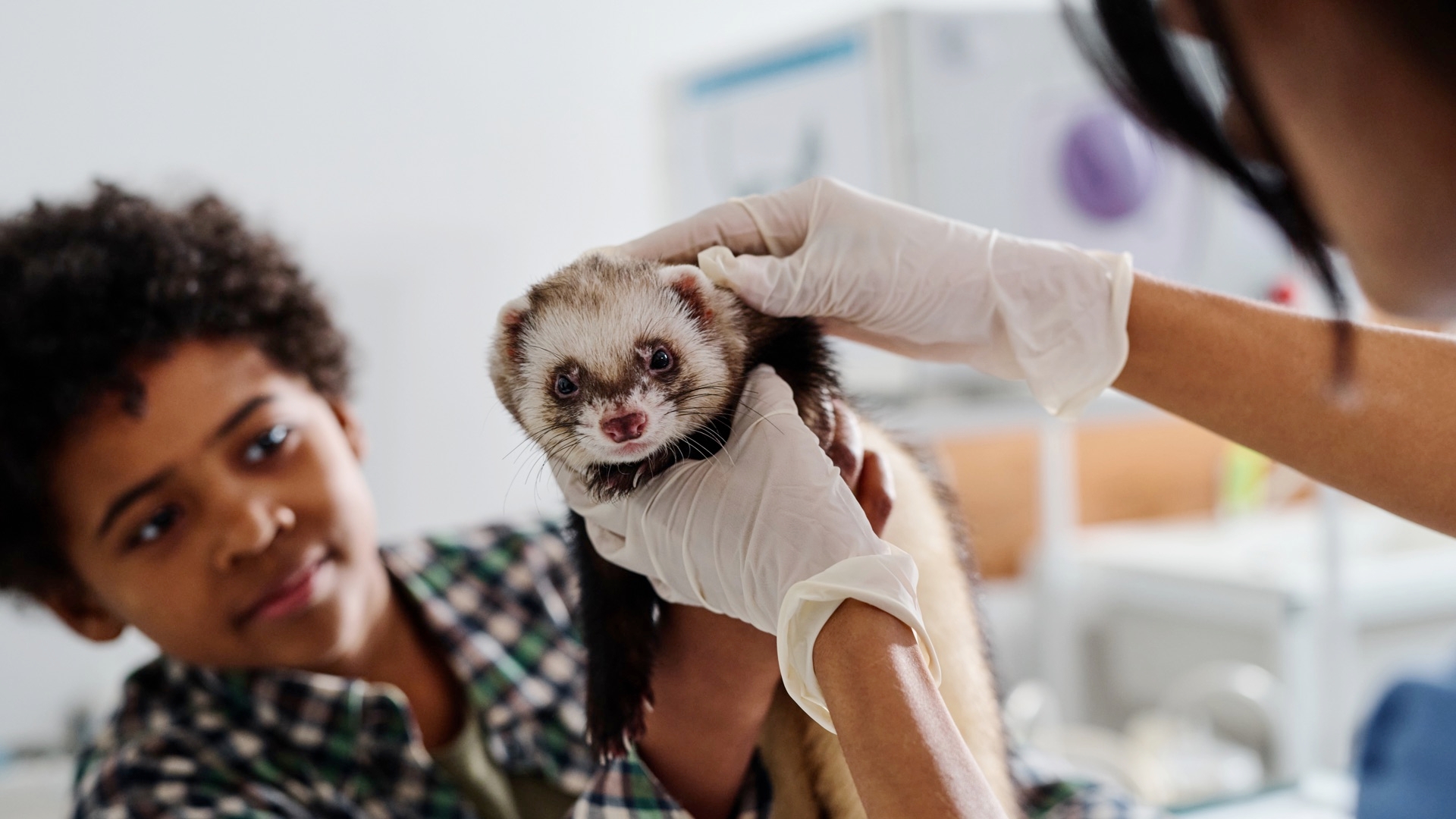A Care Guide For Your Ferret:
(Mustela Putorius Furo)
Summary:
Congratulations! You are bringing a ferret into your home. Here is what you need to know and expect from your new fuzzy family member. This article will cover everything: supplies you'll need, behavior, socialization, diet, expected lifespan, habitat, grooming and more.


Congratulations! You are bringing a ferret into your home. Here is what you need to know, and what you can expect from your new fuzzy family member.
Supplies needed
- Habitat: large cage (at least 3 feet by 2 feet by 2 feet) with at least two floors
- Litter box with wood or paper pellets
- Food and water bowls F Water bottle
- Fleece bedding and hammock
- Ferret food
- Toys (variety, no rubber or foam)
- Nail trimmers F Children's fluoride rinse
Behavior
Ferrets are wacky little creatures. They're curious, naughty, and playful when they're awake, but they sleep most of the day. Ferrets are usually only awake for about four hours a day, but they want to be out and about during those hours. They love to chase each other, or you, around the room, through tubes, and under blankets. They may do a "war dance" — open their mouths and jump backward — a signal that they want to play. They love to steal and stash things, especially socks or items with exciting textures.
Your ferret needs at least a couple of hours a day out of its cage to run around and explore. Most ferrets can entertain themselves, especially if they have a ferret friend to run around with and a toy or two. Having a ferret run around the room is a ton of fun, but remember — they are mischievous little critters. If their heads can fit through a gap, they can go through it, which can be dangerous (e.g., getting stuck behind the fridge or in a ventilation shaft). If they steal something they shouldn't have (e.g., shoes, the remote control, your keys, a bag of treats), you'll have to put it somewhere they can't reach it.
Socialization
Ferrets can quickly learn to be playmates with humans. To pick up your ferret, hold him under the armpits. You can scoop him like a baby or let him hang against you. If he is not used to being handled, he might bite. If this happens, don't immediately set him down (or he'll learn that biting is how he asks to get down). With regular handling and communication, your ferret should eventually learn not to bite.
Diet
Ferrets should always have food and water available. They can drink water from bowls or bottles. Different ferrets do better with different water sources, so try both with yours. For food, it is good to feed a mix of at least two to three different ferret kibbles. It's best to stick to ferret food, since it was designed to meet ferrets' dietary needs. Cat food is similar to ferret food but often has less of certain nutrients (like taurine) that are important for ferrets.
Ferrets are picky eaters, and switching them to a new food can be hard. Mixing different kibbles is important in case one of them switches to a new recipe your ferret does not like or goes out of stock. When introducing a new food, mix a small amount of it with the food he was already eating, gradually increasing the amount as he gets used to it. That way, your ferret does not have to abruptly change to an unfamiliar food that he will not eat for the first few days.
For treats, there are many commercial ferret treat brands. Do not give your ferret anything high in sugar; never give chocolate or anything with artificial sweeteners. Ferrets are carnivores and cannot digest plant fiber, so avoid most human foods. Some ferrets like meaty treats. Plain chicken, jerky, or other meats are OK in small amounts if your ferret is interested.
Lifespan
Ferrets typically live five to eight years.
Habitat
Ferrets need a large enough cage to have their food/water, litter box, and bedding in separate areas. A good rule of thumb is to use a cage at least 3 feet by 2 feet by 2 feet. Multilevel cages are best.
Ferrets should have a litter box and multiple places they can sleep in their cage. For bedding, pillowcases make good cage-floor covers. Ferrets love to sleep in hammocks, and most ferrets like fleece blankets or unfinished fleece from the craft store. Some ferrets will try to eat fleece, so they need to be switched to bed sheets or flannel. Their bedding should be washed about once a week or anytime they poop or pee on it. It's good to regularly wipe down the cage floors with diluted bleach water to clean up unnoticed accidents and sweep away any kibble crumbs.
In their litter boxes, ferrets can use wood, paper pellets, or newspaper. Avoid clay kitty litter since ferrets will dig around and get it stuck in their lungs. Your ferret should be able to comfortably fit in the box without curling up. You should expect to scoop the litter box daily.
Temperature and humidity
Ferrets do best between 60-75 degrees F. They cannot sweat, so hot temperatures and/or high humidity are dangerous. Make sure to keep your ferret's habitat away from windows and direct drafts.
Grooming
Ideally, ferrets must have their nails, ears, and teeth groomed every two weeks. Although we provide guidance below, we suggest watching online videos to learn how to groom your ferret.
For nail trims, you can use human or ferret nail clippers. It's easiest to distract them with an oil treat while you do this. A few drops of salmon oil or commercial ferret treat oil on their bellies will keep them distracted while you trim. Always clip so the nail is getting squished side-to-side rather than up-and-down to avoid breaking the nail, which can be painful. Never clip into the pink "quick" of the toenail, only trim off the white ends. You will know if you have clipped too short, because your ferret will flinch and bleed. Should that happen, you will need to use cornstarch or a styptic powder to stop the bleeding. Nails too long can hurt your ferret when he walks and get caught in things.
For ear and teeth cleaning, you will need to scruff your ferret. To do this, get a firm grip on the extra skin on the back of his neck.
Use a cotton swab to swoop around the back of your ferret's ear for ear cleaning. Never clean toward his face or you could damage his hearing. Dark brown earwax is normal and should go away after three to five swabs. Use a clean swab every time.
Use a cotton swab dipped in children's fluoride rinse for teeth cleaning. Rub your ferret's gums (they may bleed slightly if they are not used to this), and rub as many surfaces of his teeth as you can.
Toys
Ferrets will play with just about anything. They are happy with paper bags and cardboard boxes of all sizes. They love tubes. Some ferrets also love cat toys and tennis balls.
Avoid rubber or foam toys. Ferrets can rip pieces off and eat them, which can cause serious internal blockages. If you see your ferret chewing pieces off any toy, you should take it away from him to avoid health problems.

